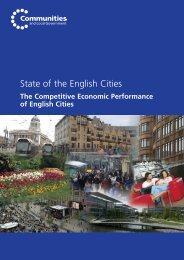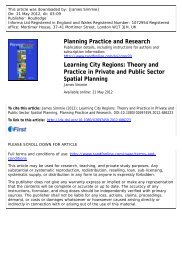History Matters: Path dependence and innovation in British city ...
History Matters: Path dependence and innovation in British city ...
History Matters: Path dependence and innovation in British city ...
You also want an ePaper? Increase the reach of your titles
YUMPU automatically turns print PDFs into web optimized ePapers that Google loves.
Part 4: Why do cities differ <strong>in</strong> <strong>in</strong>novative performance?<br />
Conclusions <strong>and</strong> some lessons for policy<br />
4.1 Introduction<br />
In this chapter we draw together our f<strong>in</strong>d<strong>in</strong>gs<br />
<strong>and</strong> <strong>in</strong>terpret them <strong>in</strong> the light of our <strong>in</strong>itial<br />
theoretical approach. We l<strong>in</strong>k those f<strong>in</strong>d<strong>in</strong>gs<br />
to the concept of path <strong>dependence</strong> <strong>and</strong> the<br />
contributions of absorptive capa<strong>city</strong> <strong>and</strong> local<br />
<strong><strong>in</strong>novation</strong> systems to the creation of new<br />
pathways <strong>in</strong> <strong>city</strong>-regional economies <strong>and</strong> the<br />
determ<strong>in</strong>ation of the trajectories that they<br />
follow subsequently. In do<strong>in</strong>g this we note<br />
the methodological difficulties <strong>in</strong>volved <strong>in</strong><br />
analys<strong>in</strong>g some elements of the conceptual<br />
framework us<strong>in</strong>g the available time series<br />
datasets that only span a period of around 25<br />
years, when some urban <strong>in</strong>dustrial legacies go<br />
back over many decades.<br />
4.2 Knowledge, absorptive capa<strong>city</strong> <strong>and</strong><br />
local <strong><strong>in</strong>novation</strong> systems<br />
We have argued that knowledge assets <strong>and</strong><br />
the creation of new knowledge are critical<br />
driv<strong>in</strong>g forces underly<strong>in</strong>g both the creation of<br />
new pathways <strong>and</strong> the subsequent parameters<br />
determ<strong>in</strong><strong>in</strong>g the trajectories that they follow.<br />
In particular, the historical development of<br />
the aggregate capacities of urban economies<br />
to identify, assimilate <strong>and</strong> exploit knowledge<br />
(their absorptive capa<strong>city</strong>) determ<strong>in</strong>es the<br />
range of possibilities for their immediate future<br />
development. Those possibilities that they<br />
explore are controlled by their systemic abilities<br />
to make use of these assets to generate or<br />
adopt new knowledge <strong>and</strong> to translate it <strong>in</strong>to<br />
commercial products <strong>and</strong> services (their local<br />
<strong><strong>in</strong>novation</strong> systems).<br />
Our evidence on technological lock-<strong>in</strong> as<br />
a source of path <strong>dependence</strong> is that it can<br />
sometimes lead to decl<strong>in</strong>e or to reluctance<br />
to adopt new pathways. In Swansea, for<br />
example, there have been two major waves of<br />
growth <strong>and</strong> decl<strong>in</strong>e as a result of technological<br />
lock-<strong>in</strong>. The local economy was once based<br />
on the extractive <strong>in</strong>dustries m<strong>in</strong><strong>in</strong>g coal, iron,<br />
copper, t<strong>in</strong> <strong>and</strong> z<strong>in</strong>c. At its peak, Swansea<br />
was produc<strong>in</strong>g 60 per cent of the world’s<br />
copper requirements. But a comb<strong>in</strong>ation of<br />
decl<strong>in</strong><strong>in</strong>g natural resources <strong>and</strong> a failure to<br />
break out of <strong>and</strong> diversify its longst<strong>and</strong><strong>in</strong>g<br />
m<strong>in</strong><strong>in</strong>g technologies led to the closure of most<br />
of these <strong>in</strong>dustries by the 1960s <strong>and</strong> 1970s.<br />
This lesson had not been learned when the<br />
second wave of growth developed on the<br />
basis of foreign <strong>in</strong>vestment <strong>in</strong> electronics. The<br />
technologies used <strong>in</strong> the production of cathode<br />
ray tubes (CRTs) <strong>and</strong> video cassette recorders<br />
(VCRs) were quickly rendered obsolete by the<br />
new technologies of plasma <strong>and</strong> liquid crystal<br />
display (LCD) screens <strong>and</strong> digital record<strong>in</strong>g<br />
devices such as DVD recorders. In both cases,<br />
the local economy rema<strong>in</strong>ed locked-<strong>in</strong> to<br />
technologies that were overtaken either by<br />
the discovery <strong>and</strong> exploitation of alternative<br />
sources of natural resources or by the <strong>in</strong>vention<br />
of replacement technologies. By the time the<br />
scale of these “gales of creative destruction”<br />
was recognised locally it was too late to do<br />
much about it.<br />
Some respondents have suggested that even<br />
Cambridge may be subject to an element of<br />
technological lock-<strong>in</strong>. So, despite successive<br />
waves of development spann<strong>in</strong>g related<br />
developments <strong>in</strong> IT, life-sciences, software,<br />
<strong>and</strong> biotechnology it can be argued that<br />
many of these new pathways are l<strong>in</strong>ked by<br />
similar cognitive frameworks <strong>in</strong> advanced<br />
comput<strong>in</strong>g. Despite this, there are emerg<strong>in</strong>g<br />
areas concerned with media applications of<br />
advanced comput<strong>in</strong>g, currently clustered <strong>in</strong><br />
62













